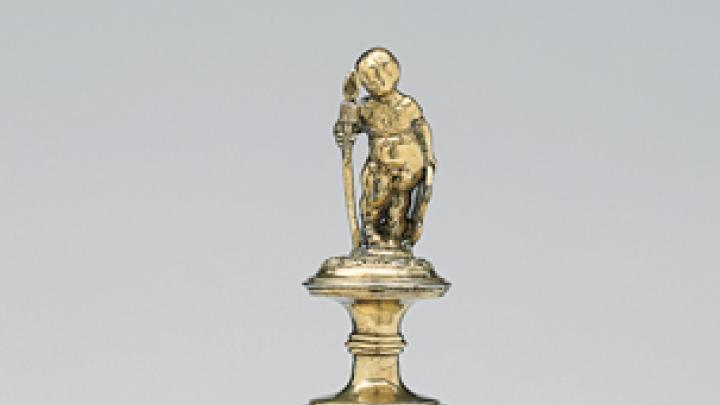Quaffers today may never have imagined such a thing as a goblet made from a coconut and gilt silver, but about four centuries ago cups such as the one shown here were well known to a species of European collector. These vessels were often displayed in a so-called cabinet of curiosities, or Wunderkammer, usually room-sized, containing a hodgepodge of remarkable items ranging from preserved animals, skeletons, minerals, alleged mermaids, and the tusks of narwhals (but said to come from unicorns), to wondrous man-made objects: ethnographic specimens from exotic locations, antiquities, clockwork automata, paintings, sculptures. Some 1,500 coconut goblets from the early modern period survive. Danielle Charlap ’09 wrote an 87-page undergraduate history honors thesis about them, entitled “Chasing Wonder: Coconut Cups Collected in Europe, 1500-1700.” She examined in particular this one, from the Harvard Art Museums/Busch-Reisinger Museum. Hans Peter Müller, a silversmith active in Breslau, Germany, fashioned it around 1600.
“Prior to the sixteenth century, Europeans had yet to round the Cape of Good Hope, making coconuts a real rarity, meriting their place among medieval church wonders working in the service of God,” writes Charlap. As Westerners spread the coconut palm from southeastern Asia to western Africa, Brazil, and the Caribbean, the nuts would become a commodity with many uses, including as a source of copra and coir. Müller made this goblet at a time when the status of coconuts was changing from rare to commonplace, but a nut carved with scenes in relief and covered with richly wrought silver was deserving of a place in anyone’s Wunderkammer as an example of “the blurring, testing, and teasing of the line between nature and artifice.” Charlap sees the Wunderkammer owner as part of a pan-European “elite club of Humanist collectors engaged in questions of nature and art.” (She has moved on from coconuts and is now an assistant curator at the Museum of Jewish Heritage—A Living Memorial to the Holocaust, in New York City, where she is at work on an Emma Lazarus exhibition.)
Müller’s goblet is part of the Tangible Things exhibition—on view through May 29 in galleries at the Historical Scientific Instruments Collection in the Science Center and at several other Harvard venues, and previously explored in this space (see March-April, page 68) and online (at harvardmagazine.com/2011/03/out-of-place). A co-curator of that exhibition is senior lecturer Ivan Gaskell, who guided Charlap in preparing her thesis. The exhibition brings together 200 intriguing things from disparate collections throughout the University; one of its goals is to challenge viewers to consider the way in which a thing has been categorized traditionally and whether it might be thought of and arranged differently. Thus a number of objects are displayed not in their usual surroundings but, unexpectedly, elsewhere. A plain, wooden, beautifully curved Native American bow has left its shelf at the Peabody Museum of Archaeology and Ethnology to appear upright in a case at the Harvard Art Museums among sculptures and paintings. This goblet is temporarily in the Houghton Library, where it appears in a gallery among a small collection of Bibles—starting with Gutenberg’s—famous for the beauty of their typography and design. The cup, too, tells a Bible story. Müller carved into the nut scenes from the life of Samson, showing him removing the gate of Gaza, combating the lion, and smiting Philistines with the jawbone of an ass.








